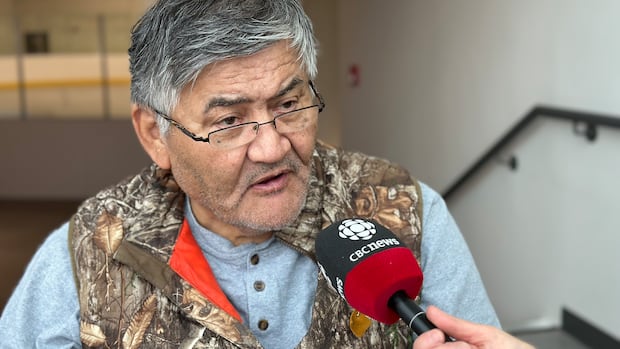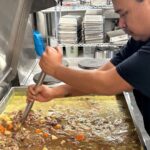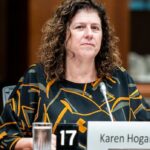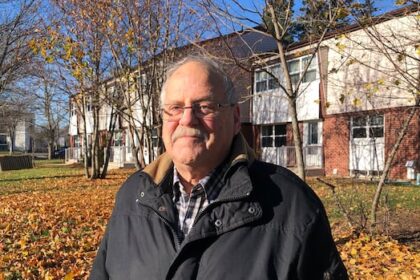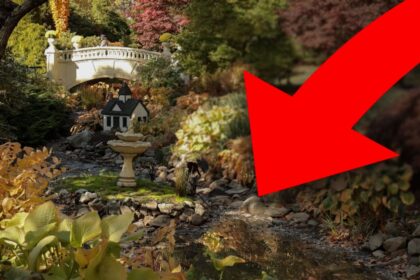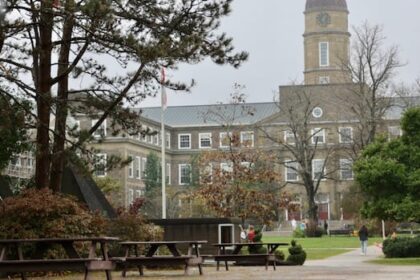Reflecting on his time so far as the chief of the Little Salmon/Carmacks First Nation in the Yukon, Russell Blackjack says there are still many issues in his community that trouble him.Russell was elected nearly a year ago to another term as chief. It’s a position he’s held before. Speaking on Friday to CBC’s Midday Café guest host Nancy Thomson, Russell said he worries about the drugs entering into his central Yukon community, as well as what he feels is a lack of proper consultation on the territory’s new minerals legislation. This interview has been edited for length and clarity.You were elected in November of 2024. After a year in office, how are you feeling in the position?I feel pretty good myself, but there’s still a lot of issues we have to deal with, mostly alcohol and drugs, which is one of the biggest problems that we have here in our community.It’s still an ongoing thing. I really don’t know how you would tackle an issue like that. I think it’s more accessible for people to get these drugs nowadays because of the people who are bringing them in, the drug dealers. They have no fear of the court system. The convictions are slated in the Criminal Code. Yet when the courts deal with it, if they’re convicted, it’s a slap on the hand, and they don’t realize the circumstances of all the people that are dying from these drugs and how the young kids are getting addicted to it. You were an RCMP officer here in the Yukon and in Alberta for 30 years, so I suppose you’ve seen it from the law enforcement perspective as well, and probably seen a lot of things there related to that?During my years in the RCMP, when dealing with drugs, we did the paperwork and got them to court. That was the process that we had and from there the courts dealt with the convictions. But here, now as a chief, [I’m] seeing my people go through all these problems and addictions, and I’ve known a lot of these people most of my life, all my life in fact, and they were strong, good, young, healthy people. So you’re seeing the loss of potential, I suppose, that must grieve you as a leader?The loss of potential, the loss of their physical capabilities, and even their mental capabilities are lost. And yes, it does hurt me quite a bit.In the nearly 30 years since the Little Salmon/Carmacks First Nation signed its final agreement, do you think expectations have been met with regards to what people thought would happen with that agreement?I can’t say it’s [been] met, but the First Nations people have grown to work with what we have got. And being a self-government is a pride that we have here as a First Nation. And when I say it hasn’t been met, you still get issues where people will try to discredit our final agreement giving it a different view. One of the premiers a few years back, when a question was asked to him saying, “well, this says under the final agreement…”, [the premier] said to the person, the chief, “a final agreement was written for interpretation.” This is pretty hard to deal with and these are types of problems we deal with everyday. This was more the mining issues that we were dealing with at that time. Since then, they have looked at a mineral legislation and that never went through. They tried to push it through but it just didn’t have the problems that we’ve seen and they weren’t dealing with it.So that new mineral legislation, that’s gone nowhere right now. What does your First Nation want to see from the next territorial government?Our biggest issue with all the miners is the environmental protection and the environmental cleanups. The other thing besides that is the continuity of the areas that they go into. Most of the areas that they go into are historical to their First Nations. Keeping good communication with the First Nations on what exactly they’re going to do. They need a work plan to go into that. We’ve been telling them right from the beginning to work with us on that, and yet, whenever we put in our concerns and stuff, it’s never met. Do you feel that you’ve been consulted adequately on the development of this mining framework?We’ve been consulted, but not adequately, because there are still issues that we want to deal with, and we want them to deal with. Yet the process is still going ahead with the encouragement of the government.A court order was issued saying you can’t stake any claims in the Ross River traditional territory unless there’s adequate consultation and accommodation. That’s been the case since 2013. There hasn’t been a claim staked in Ross River’s territory since then. Do you think that the other First Nations look at that and think that’s what you’d like to see in mining legislation – that ability to control where people stake and how?That to me is a problem, because Ross River hasn’t signed their final agreement, yet the government is giving them all the alternatives. And we, as a signed First Nation, they won’t give us that alternative. This is where you get all these different placer miners and stakers coming into our traditional territory and staking. The southeast of Little Salmon/Carmacks First Nation is an area that’s sacred to us. It’s a heritage area. And yet they’ve allowed them to go and stake it all up. This photo, included in a February 2024 Yukon government inspection report on the Mount Nansen mine site, shows a seepage pond viewed from the tailings dam. (Yukon government)Speaking of mining, there’s the Mount Nansen mine site in your territory. It is undergoing remediation. What is your nation’s involvement with that?Besides negotiating with the work plan on the remediation, they have some of our First Nations people working on site. I think they’re actually working on the site area, but we have to give them a little encouragement. So you know, “this should be done, this water treatment should be kept there,” because there has been in the past a lot of unsafe and untreated water coming out from the mining site and into the creeks.You’re speaking about culturally important, culturally significant areas. How important is the mine site, the land that Mount Nansen occupied? How important is that traditionally, culturally, spiritually to the Northern Tutchone people of Little Salmon and Carmacks?That whole area, before the mines were even in there, was a hunting area for our First Nations people and from the Haines Junction people that came across because it’s sort of the centralized area. The trails go from mountains right from Mount Nansen down to Aishihik Lake, and to Haines Junction, and then down to Twin Lakes over the mountains. It was a very high hunting, subsistence hunting for our First Nations.So like a grocery store?Pretty well, for our First Nations. If you wanted to go and get a moose, back in those days you go to that area and there’s areas that we have, including lakes that we have for subsistence and fishing. This was one of the things that I brought up to the minister of Fisheries and Oceans Canada [Thursday]. Now that we’ve shut down for seven years for salmon fishing, we agreed to it, but we agreed to the closure and not giving up our rights to fish. And now the sport fishers are still getting licensed to go sport fishing, so what’s happening is, without the salmon fishing, they are now going to the lakes, which will affect our fisheries in the lakes. The sport fishers are going to the lakes, the big lakes?The big lakes, yeah. I guess they have some fishing, fly-in fishing. I know in the Mandanna Lake area, Chain Lakes, Clear Lake, that’s all fly-in fishing areas.So that’s pressure upon a traditional food source for your people?Yes, it’s pressure on the freshwater fish that we have. It’s something that we know is a detriment to our First Nations. So we’re trying to, at least, slow it down, stop it.This may be a big question, but do you think the Mount Nansen Mine site will ever return to its original condition? Will it ever be pristine again?No. There’s no way it’ll ever be back to what it used to be, before the mines or before the prospectors even set foot there. The trails through there are gone. A lot of the creeks that flow through there, most of them are just creek beds now.How do you convey that sense of loss to a government agency, a government body that’s looking to issue claims or regulate the mining industry? How do you convey that to governments and industry? And do you think they’re listening?They probably are. I know they are. But it’s pretty hard to convey when you’re dealing against financial pressure. People with money, miners with money, and people willing to take the money for projects and stuff like that. We’ve been offered money for areas of our mines before. But we’d rather have our land than the money because money only goes so far. Forty years from now when I’m gone, our land will be still here and they’ll be still walking our trails that I did when I was a kid.
Wednesday, 17 Dec 2025
Canada – The Illusion
Search
Have an existing account?
Sign In
© 2022 Foxiz News Network. Ruby Design Company. All Rights Reserved.
You May also Like
- More News:
- history
- Standing Bear Network
- John Gonzalez
- ᐊᔭᐦᑊ ayahp — It happened
- Creation
- Beneath the Water
- Olympic gold medal
- Jim Thorpe
- type O blood
- the bringer of life
- Raven
- Wás’agi
- NoiseCat
- 'Sugarcane'
- The rivers still sing
- ᑲᓂᐸᐏᐟ ᒪᐢᑿ
- ᐅᑳᐤ okâw — We remember
- ᐊᓂᓈᐯᐃᐧᐣ aninâpêwin — Truth
- This is what it means to be human.
- Nokoma


